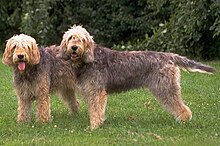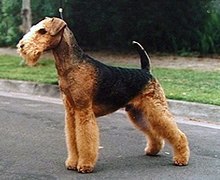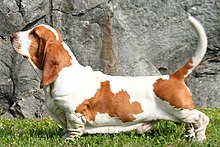
With a history interwoven with the waters and wetlands of Britain, the Otterhound is a unique breed known for its remarkable swimming prowess. Characterized by its dense, rough coat and webbed feet, this hound was bred specifically for hunting otters, a testament to its stamina and tracking abilities both in water and on land. Beyond its hunting heritage, the Otterhound’s amiable and boisterous nature ensures it remains a cherished, albeit rare, companion in homes across the globe.
The Otterhound is a member of the AKC Hound Group.
Breed Characteristics
| Dog Breed | Otterhound |
| Breed Popularity (AKC) | 176 |
| Country of Origin | United Kingdom |
| Personality | Alert/Responsive |
| Life Expectancy | 10-13 yrs |
| Height | 24-27 in |
| Weight | 80-115 lbs |
| Color | Whole coloured, grizzle, sandy, red, wheaten, blue; in combination with slight white markings on extremities. White in combination with slight lemon, blue or badger pied markings. Black and tan, blue and tan, black and cream, occasional liver, tan and liver, tan and white. |
| Coat | Double, with a soft undercoat and longer harsher outer coat. Both coats are slightly oily. |
| Shedding | Seasonal |
| Grooming | Weekly Brushing |
| Health Problems | Hip dysplasia, gastric torsion |
| Trainability | May be Stubborn |
| Exercise Needs | Regular Exercise |
Otterhound History
Hailing from England, the Otterhound is a rare breed with a history dating back to the 1100s. Originally bred for hunting otters, this breed has a keen sense of smell and a water-resistant double coat. Its webbed feet make it an excellent swimmer. Despite its hunting origins, it’s known for its friendly and affectionate nature.
Temperament
Otterhounds are robust and amiable, originally bred for hunting otters. Their intelligence combined with an easy-going demeanor makes them lovable companions. They exhibit a behavior that’s playful and sociable. Their energy level is moderate to high, enjoying long walks and swims. Early socialization ensures they remain affable. Their barking tendencies are moderate, primarily vocalizing when excited.
Remember, while breed traits provide a general idea, individual dogs can have personalities that differ from the breed standard. Always spend time getting to know the dog and ensure their needs and temperament align with your lifestyle.
Grooming Requirements
The Otterhound has a dense, rough coat that requires regular brushing to prevent matting. Using a dog shampoo suitable for coarse fur is recommended when bathing. Routine grooming, including nail trimming, ear cleaning, and occasional fur trimming, ensures the breed’s well-being.
Otterhound Health
Otterhounds, with a lifespan of 10-13 years, can face health challenges like hip dysplasia and gastric torsion. Regular health checks, vaccinations, flea prevention, and deworming are crucial. Offering a balanced diet and monitoring for potential allergies can support their health.
Exercise Needs
Otterhounds are rare but are known for their stamina and love for water. Regular walks, play sessions, and especially swimming can be delightful for them. Dog parks with water features can be ideal. Engaging them in scent-tracking games or gentle agility can be beneficial for their well-being.
Training
With a unique coat and webbed feet, the Otterhound is a natural swimmer and tracker. Obedience training complements their scent-driven nature. Structured commands help in achieving effective potty training. Crate training gives them a cozy retreat. Addressing behavior problems, such as their independent nature, is essential. Proper socialization ensures they’re both effective hunters and gentle family members.
Otterhound Pictures
Related Dog Breeds
More Dog Resources
Are you thinking about getting a puppy? Make sure to check out our list of important questions to ask before you adopt a puppy.
We also have many resources to help, from naming your puppy to socialization resources and training tips.
Take me back to the Ultimate Guide to Dog Breeds



